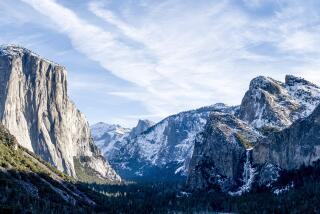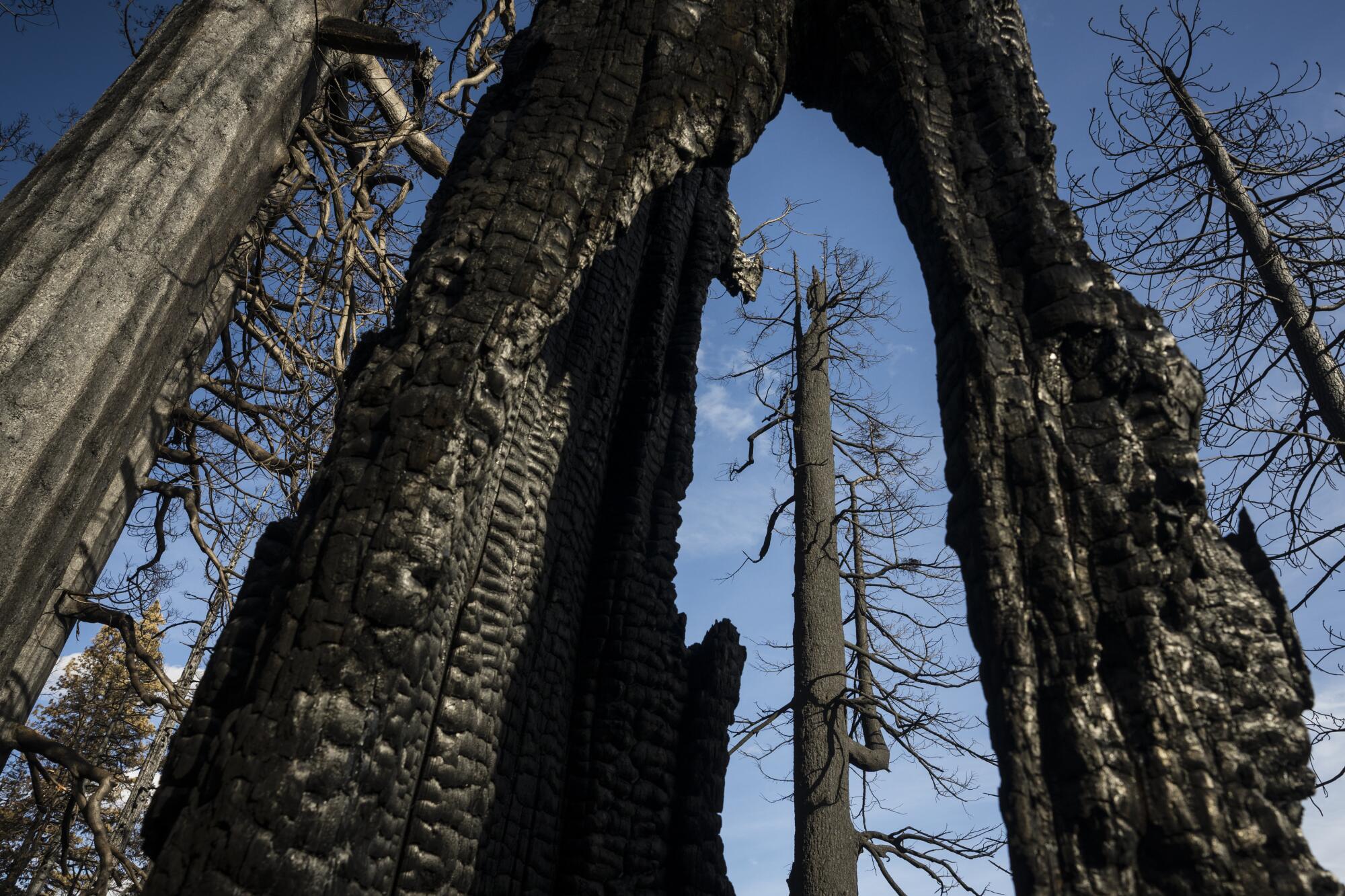
- Share via
It looked like a bomb had gone off in the vast stand of giant sequoias on a mountain ridge in the southern Sierra.
Charred trees rose — some stripped of leaves and eerily skeletal — in Kings Canyon National Park’s Redwood Mountain Grove. Ash hung in the air and clawed at visitors’ throats on a chilly afternoon in November.
Roughly seven weeks earlier, intense flames from the KNP Complex fire had charged through the grove, which is home to more than 5,200 behemoth sequoias — among the world’s largest and oldest trees.
When the smoke finally cleared, the impacts were sobering.
“It does not ever get easy looking at a monarch giant sequoia that has died,” said Teresa Benson, supervisor for the Sequoia National Forest, which also was seared by recent wildfires. “That is one of the hardest things that I’ve ever had to look at in my entire 30-year career with the Forest Service.”
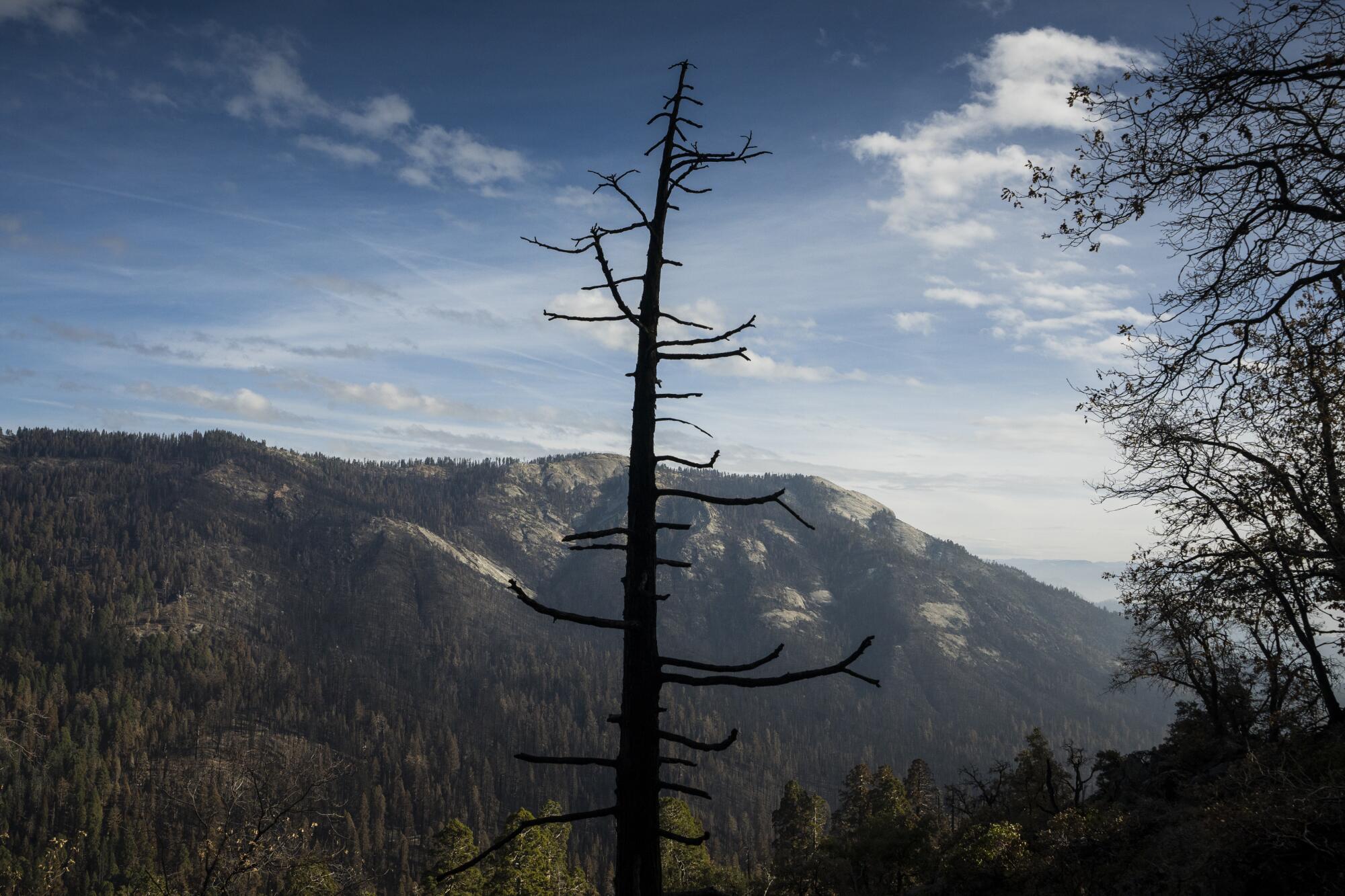
As many as 2,380 giant sequoias burned to death or are expected to die within several years because of the KNP Complex fire, which is still active. Most grew in the Redwood Mountain Grove, said Christy Brigham, chief of resources management and science for Sequoia and Kings Canyon National Parks, where the fire has seared more than 88,300 acres.
And it’s only a sliver of much greater devastation.
Another 1,250 trees may have been torched by the Windy fire, which primarily burned in the Sequoia National Forest to the south. It was sparked during the same lightning storm that ignited the KNP Complex fire in early September.
The two fires claimed up to 5% of the world’s population of giant sequoias. That’s in addition to the nearly 14% that were destroyed in last year’s Castle fire, which burned through the same area.
Among the trio of destructive fires, nearly 20% of all giant sequoias may have perished in a span of 14 months, according to Joanna Nelson, director of science and conservation planning at the nonprofit conservation group Save the Redwoods League.
The giant sequoia are found only in California, primarily on the western slopes of the southern Sierra. Before the three fires, there were approximately 75,000 of the massive specimens in the world; today that number may be as low as 60,000.
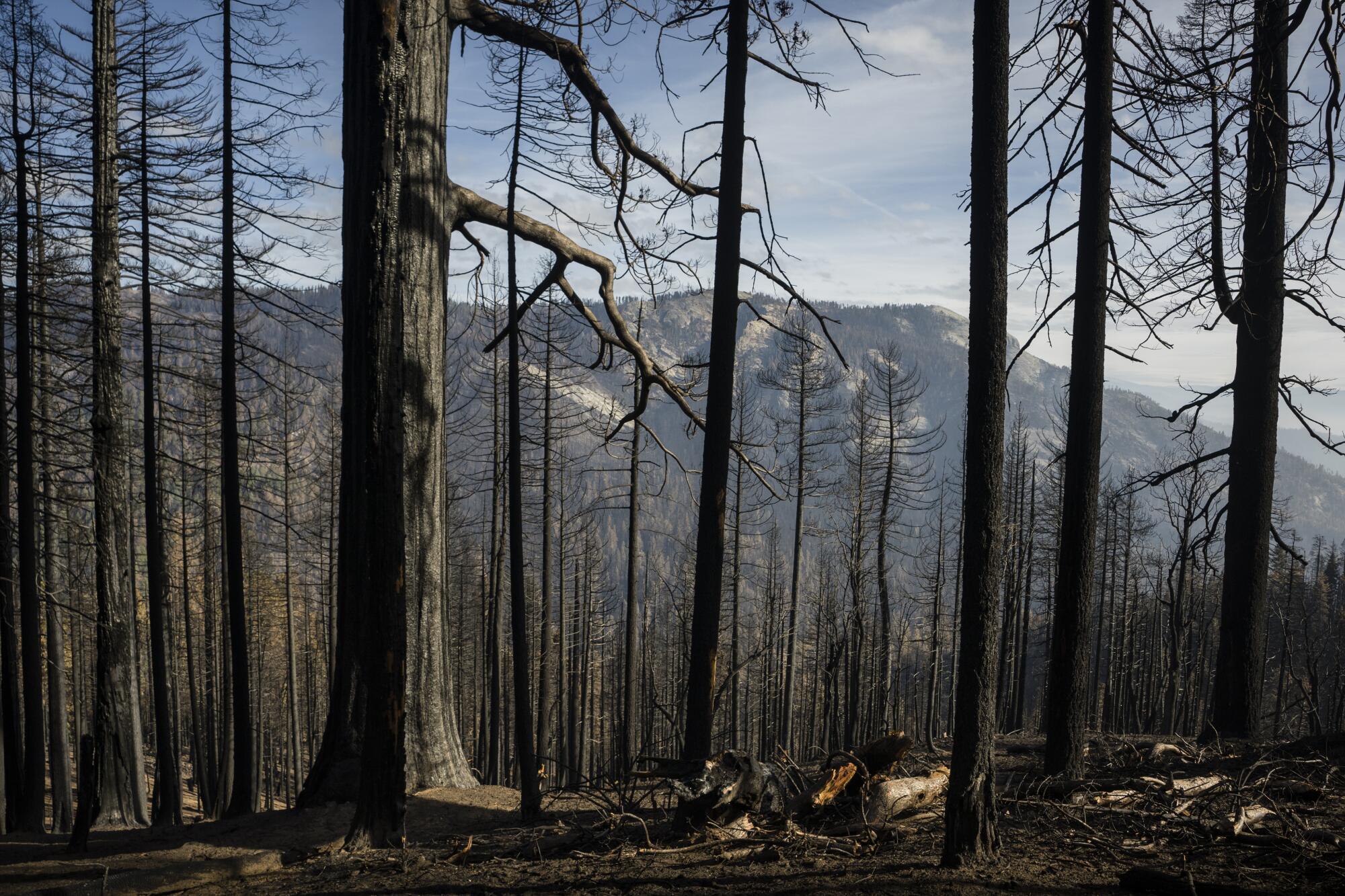
With their towering canopies and thick bark, giant sequoias have adapted to withstand low-intensity fire, and even need it to reproduce. But ferocious fires in recent years, fueled by climate change, have proved fatal to the trees experts once thought were impervious to flames.
Since 2015, high-severity fires have killed giant sequoias “in much greater numbers than has ever been recorded,” according to a report by the National Park Service. A history of fire suppression in the region, combined with stubborn drought and other factors, has caused bone-dry vegetation to build up — a tinder box that can fuel intense blazes, officials said.
Drought also has directly contributed to the sequoias’ decline, weakening their defenses and making them susceptible to incursions from bark beetles, another scourge to which they’ve historically been immune.
Before the KNP Complex fire hit Redwood Mountain Grove, Tony Caprio, fire ecologist for Sequoia and Kings Canyon National Parks, sounded the alarm.
“Tony said early on [that] the southern end of Redwood Mountain Grove is really at risk,” said Brigham, who co-authored a recent report with Caprio and others on the 2021 fire season’s impacts on giant sequoias. The report details the mortality estimates of what are considered large trees, more than 4 feet in diameter.
That part of the grove is perched on steep terrain and hadn’t been subjected to recent controlled burns to thin out fuel. Dead trees littered the area below.
Park officials knew the large grove was vulnerable, and desperately worked to prepare the area as the KNP Complex fire marched closer. Concern ran high for the grove’s thousands of sequoias.
“If fire gets established below it, there’s potential for it to run up the slope, and burn with really high severity,” explained Brigham, wearing tiny gold-dipped alder cone earrings.
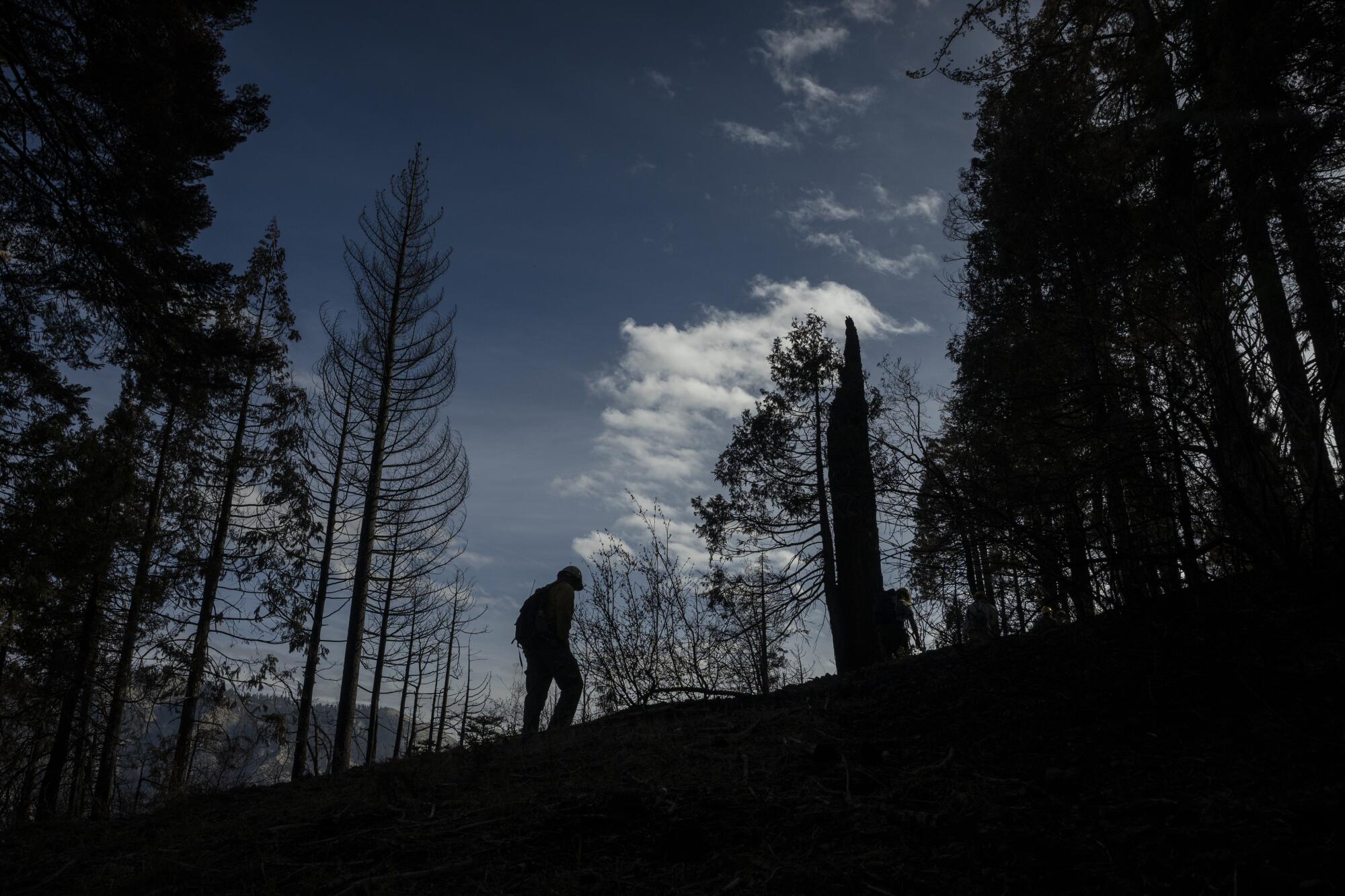
Fire crews began conducting burn operations in the grove on Oct. 1, according to the recent report, and there were plans to apply a goopy, fire-retardant gel on some of the trees — an experimental method that had never been used on sequoias prior to the KNP Complex fire. Caprio created a map of where to drop the gel using aircraft.
“But it was very smoky,” Brigham said. The plan was foiled. “And the area that we wanted to put the gel is the area that is nuked.”
By the evening of Oct. 3, the fire began to take hold in the Redwood Mountain area — before backburn operations were complete. It apparently made a run up the west side of Redwood Mountain Ridge before merging with another set of flames by the following morning, according to the report. High-severity fire seared the southern end of the ridge and lower portions of the grove in Redwood Canyon, expanding east and north.
No one was there to witness the devastation but some park officials believe that, in some areas, the blaze surged as a solid wall of flames across the tree tops — a sign of ferocious fire behavior known as a running crown fire.
Down-canyon areas burned so hot that the fire created an enormous pyrocumulus cloud that soared 40,000 feet above the burn area, said Nate Stephenson, an emeritus scientist with the U.S. Geological Survey.
The weather event generated winds so strong that they ripped bark and foliage off the sequoias, sending the debris raining down from the sky far to the north. Friends living on the eastern side of the Sierra emailed Stephenson to say they could see the gargantuan cloud over the mountains.
“It cooked down there, is my impression,” he said on Nov. 19 as he scoped out a particularly charred area of the grove higher on the mountain.
Stephenson and Brigham, who are leading experts on giant sequoias, led a media tour of a small portion of the grove that day. The grove is currently off-limits to the public. The group was joined by Caprio and Clay Jordan, superintendent of the two national parks.
Near where Stephenson stood on that recent Friday, a blackened giant loomed higher than an 18-story building. Estimated at up to 800 years old, it was alive when Genghis Khan ruled the Mongol Empire. Centuries later, it still looked sturdy as a house, its base far too broad to wrap your arms around.
But it was history now.
“There is nothing alive on that tree,” Brigham said.
Still, the tree bore cones high in its canopy. There’s a chance, Stephenson said, that the cones could drop viable seeds, potentially leading to the birth of new sequoias.
Elsewhere in the grove, where it’s believed the fire burned at a lower severity, officials noticed a similarly enormous tree emitting a stream of white smoke. It was cooking from within — and would likely continue to do so for months, parks supervisor Jordan said.
“The question is, will that tree die?” Jordan asked, noting it would be exceedingly difficult, “maybe impossible,” to extinguish the fire. Not long before the KNP Complex and Windy fires broke out, Jordan said, a pair of well-known giant sequoias — King Arthur and Floyd Otter — were seen still burning from the Castle fire a year earlier.
During the tour, scorched trees appeared suddenly amid healthy-looking growth throughthe first few miles of the grove. It’s typical for fire to burn in a “mosaic” like that, Jordan said.
Just before the tour, national park and forest leaders — along with other managers of land where giant sequoias grow — gathered for a briefing in Kings Canyon Park’s Grant Grove to deliver the grim news that thousands of sequoias probably perished this year.
The imposing General Grant tree stood a short walk from the podium. At 267 feet high and 29 feet around, it’s considered the second largest tree on Earth. No. 1 is the General Sherman Tree in Sequoia National Park.
The people at the briefing vowed to band together to protect the remaining majestic giants for future generations. Besides waging a collective battle against climate change, the stakeholders said it was crucial to thin out dense forests with prescribed fire and other techniques.
“The main goal is to protect the redwoods,” said William Garfield, chairman of the Tule River Indian Tribal Council.
The Windy fire ignited on the Tule River Indian Reservation before expanding into the nearby Sequoia National Forest. Like the sequoias, the Indigenous people have lived on the land for thousands of years.
“They carry a lot of history … and if they’re gone, that history is gone,” Garfield said.
As the light dwindled and officials and media alike cleared out, Samantha Furden, 26, and George David, 42, arrived in Grant Grove to play music and sing songs. The friends had just driven up from Los Angeles, where Furden lives.
David lives part-time in the Three Rivers area near the entrance to Sequoia National Park. He said hearing about the devastation to the trees was “actually very traumatic.”
“The trees speak to the soul,” David said. “This is my happy place.”
More to Read
Sign up for Essential California
The most important California stories and recommendations in your inbox every morning.
You may occasionally receive promotional content from the Los Angeles Times.



